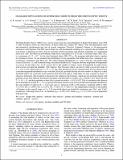De-biased populations of Kuiper Belt objects from the Deep Ecliptic Survey
Author(s)
Adams, Elisabeth Rose; Benecchi, Susan D.; Buie, Marc W.; Trilling, D. E.; Wasserman, L. H.; Gulbis, Amanda A. S.; Elliot, James L.; ... Show more Show less
DownloadAdams-2014-DE-BIASED POPULATION.pdf (582.3Kb)
PUBLISHER_POLICY
Publisher Policy
Article is made available in accordance with the publisher's policy and may be subject to US copyright law. Please refer to the publisher's site for terms of use.
Terms of use
Metadata
Show full item recordAbstract
The Deep Ecliptic Survey (DES) was a survey project that discovered hundreds of Kuiper Belt objects from 1998 to 2005. Extensive follow-up observations of these bodies has yielded 304 objects with well-determined orbits and dynamical classifications into one of several categories: Classical, Scattered, Centaur, or 16 mean-motion resonances with Neptune. The DES search fields are well documented, enabling us to calculate the probability on each frame of detecting an object with its particular orbital parameters and absolute magnitude at a randomized point in its orbit. The detection probabilities range from a maximum of 0.32 for the 3:2 resonant object 2002 GF[subscript 32] to a minimum of 1.5 × 10[superscript –7] for the faint Scattered object 2001 FU[subscript 185]. By grouping individual objects together by dynamical classes, we can estimate the distributions of four parameters that define each class: semimajor axis, eccentricity, inclination, and object size. The orbital element distributions (a, e, and i) were fit to the largest three classes (Classical, 3:2, and Scattered) using a maximum likelihood fit. Using the absolute magnitude (H magnitude) as a proxy for the object size, we fit a power law to the number of objects versus H magnitude for eight classes with at least five detected members (246 objects). The Classical objects are best fit with a power-law slope of α = 1.02 ± 0.01 (observed from 5 ≤ H ≤ 7.2). Six other dynamical classes (Scattered plus five resonances) have consistent magnitude distribution slopes with the Classicals, provided that the absolute number of objects is scaled. Scattered objects are somewhat more numerous than Classical objects, while there are only a quarter as many 3:2 objects as Classicals. The exception to the power law relation is the Centaurs, which are non-resonant objects with perihelia closer than Neptune and therefore brighter and detectable at smaller sizes. Centaurs were observed from 7.5 < H < 11, and that population is best fit by a power law with α = 0.42 ± 0.02. This is consistent with a knee in the H-distribution around H = 7.2 as reported elsewhere. Based on the Classical-derived magnitude distribution, the total number of objects (H ≤ 7) in each class is: Classical (2100 ± 300 objects), Scattered (2800 ± 400), 3:2 (570 ± 80), 2:1 (400 ± 50), 5:2 (270 ± 40), 7:4 (69 ± 9), 5:3 (60 ± 8). The independent estimate for the number of Centaurs in the same H range is 13 ± 5. If instead all objects are divided by inclination into "Hot" and "Cold" populations, following Fraser et al., we find that α [subscript Hot] = 0.90 ± 0.02, while α [subscript Cold] = 1.32 ± 0.02, in good agreement with that work.
Date issued
2014-08Department
Massachusetts Institute of Technology. Department of Earth, Atmospheric, and Planetary SciencesJournal
Astronomical Journal
Publisher
IOP Publishing
Citation
Adams, E. R., A. A. S. Gulbis, J. L. Elliot, S. D. Benecchi, M. W. Buie, D. E. Trilling, and L. H. Wasserman. “De-Biased Populations of Kuiper Belt Objects from the Deep Ecliptic Survey.” The Astronomical Journal 148, no. 3 (August 18, 2014): 55. © 2014 The American Astronomical Society
Version: Final published version
ISSN
0004-6256
1538-3881